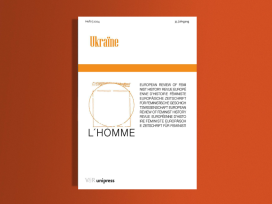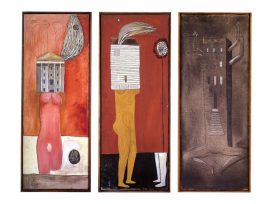Abstracts for L'Homme 1/2006
Age, Knowledge, and Gender. Considerations on the Discourse of Age in the Ancient World
What was the place of the elderly in ancient societies? Were they situated at the margins of society as recent studies suggest? Did ancient poets like Horaz or Properz chiefly marginalize old women past child-bearing age? The article refutes an essentialist reading of ancient laments about the loss of sexual attractiveness in the works of Roman elegists as realistic images of the experience of aged men or women.
Instead of reading the ancient texts as sources of individual experience it is proposed to consider them as a way of conceptualizing ideas of the social order which are projected onto the human body. Such metaphorical reading is applied to two mythological figures of endless aging, Tithonos and the Sibylle. Careful close reading makes possible an interpretation of the metamorphosis of their physical appearance from youth to old age and the survival of their voices as indications of the importance of intergenerational knowledge transfer in oral cultures.
The article concludes with some reflections about the part played by aged women in intergenerational transfer of genealogical knowledge in particular.
Social Welfare before the Welfare State: Care for the Elderly in Papal Rome (16th-19th century)
This article reflects on the issue of social welfare before the welfare state. The considerations presented here are based on a survey of institutional care for the elderly and inter-generation solidarity in modern times. Papal Rome between the 16th and 19th century frames the study in a geographical and chronological way, whilst the heuristic frame is situated around the question of dialectics between family-oriented and social solidarity; just as well the text is about the particular role of the legal systems and the judiciary apparatus concerning development and organisation of family bonds in the context of old-age-care.
One of the assumptions of the author’s research is that private charity and public relief do not belong to opposite fields of engagement, of which one might have replaced the other in the course of time. On the contrary, both areas display their dependency. They have been intertwined in the past as well as they are in the present, as the initiatives of the state and private charity both belong to the same social and cultural fields. The obligation to support weak and people in need is inscribed in a set of legal and moral commitments. Therefore those measure are rather complementary than contrary.
L’HOMME, 17, 1 (2006), 3758
Women and Ageing in the Twentieth Century
Over the course of the twentieth century a higher proportion of people than ever before lived to old age. It was a more common experience for women than for men. Also more people remained fit and healthy to later ages. Experiences of’old age’, that long period of life between around age 60 to 100 and beyond, remained very diverse, indeed probably became more so as the century progressed.’Old people’ included the very rich and powerful and the very poor and excluded, the very active and the sadly decrepit. Many things changed. In particular, by the second half of the century most people retired from paid employment whilst they were still physically fit, with a secure, if not necessarily large, pension which gave them access to a greater range of activities.
These experiences were shared by men and women though not always in identical ways: women were less likely than men to experience retirement from paid employment as a seriously disruptive break in the life-course, partly because their places in the labour market were less secure than those of men, and because they had stronger social and family ties. Women were more likely than men to suffer poverty in old age, as had long been so.
This was only one of many long-term continuities between the twentieth and earlier centuries. Other continuities included resistance to simple chronological definitions of old age and awareness of differences in individual experiences of ageing; the persistence of stereotypes of’fit’ behaviour of old women, and the resistance of women to them; and strong feelings of the importance of independence in later life and assertion of the capacity of very many (but sadly not all) people at late ages to control their own lives and to play positive roles in their families and communities rather than being dependent’burdens’ as they were often portrayed.
‘Cruel’ and’Nurturing’ Mothers. The Construction of Motherhood in Tuscany (15001800)
Working on motherhood in the early modern period entails coming to terms with fragmentary and contradictory evidence: on the one hand, we are faced with a rather static representation in discourse and iconography; on the other hand, with the multiple experience of mothers in history. Working on motherhood means understanding the ways in which the powerfully subjective and intimate experience of giving birth is measured against the public apparatus of legal norms that from classical antiquity until the present control the bodies of women.
Both in Italy and Europe research on motherhood took off in the Nineties, and it has barely touched on the affective qualities of maternity. Scholars have mainly concentrated on demographic data concerning pregnancy and childbirth, breast- feeding, wet-nursing and weaning, pedagogical literature, advice books and medical tracts on midwifery.
Until recently, historical research has neglected the subjective dimensions of motherhood. Motherhood and motherly affection are very difficult to pin down as even religious literature, like family memoirs, does not acknowledge motherly experience as something which extends beyond the physiological process of birth and feeding, and confines its representation within a set of repetitive gestures.
Published 4 August 2006
Original in English
Contributed by L'Homme © L'Homme Eurozine
PDF/PRINTNewsletter
Subscribe to know what’s worth thinking about.



